The Use of Organoclays as Excipient for Metformin Delivery: Experimental and Computational Study
Abstract
:1. Introduction
2. Results and Discussion
2.1. Characterization of Clays
2.2. Characterization of Composite MET/Clays
2.3. Effect of pH on MET Loading by Clays
2.4. Drug Binding Isotherm
2.5. Adsorption Kinetics
2.6. Influence of Temperature
2.7. Release of MET/Clay
2.8. Computational Modeling
3. Materials and Methods
3.1. Chemicals
3.2. Preparation of an Organophilic Clay
3.3. Preparation of MET/Clay Composite
3.4. Release of MET/Clays
3.5. Characterization Methods
3.6. Computational Modeling
4. Conclusions
Author Contributions
Funding
Data Availability Statement
Acknowledgments
Conflicts of Interest
References
- Aguzzi, C.; Cerezo, P.; Viseras, C.; Caramella, C. Use of clays as drug delivery systems: Possibilities and limitations. Appl. Clay Sci. 2007, 36, 22–36. [Google Scholar] [CrossRef]
- Viseras, C.; Aguzzi, C.; Cerezo, P.; Bedmar, M.C. Biopolymer-clay nanocomposites for controlled drug delivery. Mater. Sci. Technol. 2008, 24, 1020–1026. [Google Scholar] [CrossRef]
- Viseras, C.; Cerezo, P.; Sanchez, R.; Salcedo, I.; Aguzzi, C. Current challenges in clay minerals for drug delivery. Appl. Clay Sci. 2010, 48, 291–295. [Google Scholar] [CrossRef]
- García-Villén, F.; Carazo, E.; Borrego-Sánchez, A.; Sánchez-Espejo, R.; Cerezo, P.; Viseras, C.; Aguzzi, C. Clay minerals in drug delivery systems. In Micro and Nano Technologies, Modified Clay and Zeolite Nanocomposite Materials: Environmental and Pharmaceutical Applications; Merurio, M., Sarkar, B., Landella, A., Eds.; Elsevier: Amsterdam, The Netherlands, 2018; pp. 129–166. [Google Scholar]
- Viseras, C.; Carazo, E.; Borrego-Sánchez, A.; García-Villén, F.; Sánchez-Espejo, R.; Cerezo, P.; Aguzzi, C. Clay minerals in skin drug delivery. Clays Clay Miner. 2019, 67, 59–71. [Google Scholar] [CrossRef]
- García-Villén, F.; Viseras, C. Clay-based pharmaceutical formulations and drug delivery systems. Pharmaceutics 2020, 12, 1142. [Google Scholar] [CrossRef]
- Nomicisio, C.; Ruggeri, M.; Bianchi, E.; Vigani, B.; Valentino, C.; Aguzzi, C.; Viseras, C.; Rossi, S.; Sandri, G. Natural and Synthetic Clay Minerals in the Pharmaceutical and Biomedical Fields. Pharmaceutics 2023, 15, 1368. [Google Scholar] [CrossRef]
- Riela, S.; Borrego-Sánchez, A.; Cauteruccio, S.; de Melo Barbosa, R.; Massaro, M.; Sainz-Díaz, C.I.; Sánchez-Espejo, R.; Viseras-Iborra, C.; Licandro, E. Exploiting the interaction between halloysite and charged PNAs for their controlled release. J. Mater. Chem. B 2023, 11, 6685–6696. [Google Scholar] [CrossRef]
- Meirelles, L.; Carazo, E.; Borrego-Sánchez, A.; Barbosa, R.; Moura, T.; Aguzzi, C.; Sainz-Diaz, C.I.; Viseras, C.; Raffin, F. Design and characterization of a tuberculostatic hybrid based on interaction of ethambutol with a raw palygorskite. Appl. Clay Sci. 2019, 181, 105213. [Google Scholar] [CrossRef]
- Borrego-Sánchez, A.; Sánchez-Espejo, R.; García-Villén, F.; Viseras, C.; Sainz-Díaz, C.I. Praziquantel–clays as accelerated release systems to enhance the low solubility of the drug. Pharmaceutics 2020, 12, 914. [Google Scholar] [CrossRef]
- Kelch, S.E.; Ferrage, E.; Lanson, B.; Charlet, L.; Aristilde, L.; Murray, H.H. Water Trapping Dynamics in Carbohydrate-Populated Smectite Interlayer Nanopores. J. Phys. Chem. C 2019, 123, 28816–28827. [Google Scholar] [CrossRef]
- Chaari, I.; Fakhfakh, E.; Medhioub, M.; Jamoussi, F. Comparative study on adsorption of cationic and anionic dyes by smectite rich natural clays. J. Mol. Struct. 2019, 1179, 672–677. [Google Scholar] [CrossRef]
- Cavalcanti, G.R.S.; Fonseca, M.G.; da Silva-Filho, E.C.; Jaber, M. Thiabendazole/bentonite hybrids as controlled release systems. Colloids Surf. B Biointerfaces 2019, 176, 249–255. [Google Scholar] [CrossRef] [PubMed]
- Saadat, S.; Rawtani, D.; Parikh, G. Clay minerals-based drug delivery systems for anti-tuberculosis drugs. J. Drug Deliv. Sci. Technol. 2022, 76, 103755. [Google Scholar] [CrossRef]
- Wan, M.; Li, Z.; Hong, H.; Wu, Q. Enrofloxacin uptake and retention on different types of clays. J. Asian Earth Sci. 2013, 77, 287–294. [Google Scholar] [CrossRef]
- Park, J.H.; Shin, H.J.; Kim, M.H.; Kim, J.S.; Kang, N.; Lee, J.Y.; Kim, K.T.; Lee, J.I.; Kim, D.D. Application of montmorillonite in bentonite as a pharmaceutical excipient in drug delivery systems. J. Pharm. Investig. 2016, 46, 363–375. [Google Scholar] [CrossRef]
- Gamoudi, S.; Srasra, E. Characterization of Tunisian clay suitable for pharmaceutical and cosmetic applications. Appl. Clay Sci. 2017, 146, 162–166. [Google Scholar] [CrossRef]
- Amraoui, A.; Gamoudi, S.; Baenas, N.; Periago, M.J.; Srasra, E. Ecofriendly hybrid materials made from Tunisian clay and natural flowers. Clay Miner. 2023, 57, 150–159. [Google Scholar] [CrossRef]
- Berillo, D.; Ermukhambetova, A. The review of oral adsorbents and their properties. Adsorption 2024, 30, 1505–1527. [Google Scholar] [CrossRef]
- Chen, Y.; Zhou, A.; Liu, B.; Liang, J. Tramadol hydrochloride/montmorillonite composite: Preparation and controlled release of the drug. Appl. Clay Sci. 2010, 49, 108–112. [Google Scholar] [CrossRef]
- Moreno-Domínguez, E.; Borrego-Sánchez, B.A.; Sánchez-Espejo, R.; Viseras, C.; Sainz-Díaz, C.I. Experimental and Computational Study for the Design of Sulfathiazole Dosage Form With Clay Mineral. Pharmaceutics 2023, 15, 575. [Google Scholar] [CrossRef]
- Sheela, N.R.; Muthu, S.; Sampathkrishnan, S. FTIR, FT Raman and UV-Visible Spectroscopic Analysis on Metformin Hydrochloride. Asian J. Chem. 2010, 22, 5049–5056. [Google Scholar]
- Bartolucci, G.; Pallecchi, M.; Braconi, L.; Dei, S.; Teodori, E.; Lapolla, A.; Sartore, G.; Traldi, P. Mass Spectrometry Study about In Vitro and In Vivo Reaction between Metformin and Glucose: A Preliminary Investigation on Alternative Biological Behavior. Int. J. Mol. Sci. 2023, 25, 180. [Google Scholar] [CrossRef] [PubMed]
- Halimi, J.M.; Azizi, M.; Bobrie, G.; Bouché, O.; Deray, G.; des Guetz, G.; Lecomte, T.; Levy, B.; Mourad, J.J.; Nochy, D.; et al. Vascular and renal effects of anti-angiogenic therapy. Nephrol. Ther. 2008, 4, 602–615. [Google Scholar] [CrossRef] [PubMed]
- Rebitski, E.P.; Darder, M.; Sainz-Díaz, C.I.; Carraro, R.; Aranda, P.; Ruiz-Hitzky, E. Theoretical and experimental investigation on the intercalation of metformin into layered clay minerals. Appl. Clay. Sci. 2020, 186, 105418. [Google Scholar] [CrossRef]
- Molina-Montes, E.; Timón, V.; Hernández-Laguna, A.; Sainz-Díaz, C.I. Dehydroxylation mechanisms in Al3+/Fe3+ dioctahedral phyllosilicates by quantum mechanical methods with cluster models. Geochim. Cosmochim. Acta 2008, 72, 3929–3938. [Google Scholar] [CrossRef]
- Ortega-Castro, J.; Hernández-Haro, N.; Dove, M.T.; Hernández-Laguna, A.; Sainz-Díaz, C.I. Density functional theory and Monte Carlo study of octahedral cation ordering of Al/Fe/Mg cations in dioctahedral 2:1 phyllosilicates. Am. Mineral. 2010, 95, 209–220. [Google Scholar] [CrossRef]
- Iuga, C.; Sainz-Díaz, C.I.; Vivier-Bunge, A. On the OH initiated oxidation of C2–C5 aliphatic aldehydes in the presence of mineral aerosols. Geochim. Cosmochim. Acta 2010, 74, 3587–3597. [Google Scholar] [CrossRef]
- Escamilla-Roa, E.; Huertas, F.J.; Hernández-Laguna, A.; Sainz-Díaz, C.I. A DFT study of the adsorption of glycine in the interlayer space of montmorillonite. Phys. Chem. Chem. Phys. 2017, 19, 14961–14971. [Google Scholar] [CrossRef]
- Kozaka, M.; Domka, L. Adsorption of the quaternary ammonium salts on montmorillonite. J. Phys. Chem. Solids 2004, 65, 441–445. [Google Scholar] [CrossRef]
- Yílmaz, N.; Yapar, S. Adsorption properties of tetradecyl- and hexadecyl-trimethylammonium bentonites. Appl. Clay Sci. 2004, 27, 223–228. [Google Scholar] [CrossRef]
- Zhao, Z.; Tang, T.; Qin, Y.; Huang, B. Relationship between the Continually Expanded Interlayer Distance of Layered Silicates and Excess Intercalation of Cationic Surfactants. Langmuir 2003, 19, 9260–9265. [Google Scholar] [CrossRef]
- Jinhong, Z.; Xiancai, L.; Jianxi, Z.; Xiandong, L.; Jingming, W.; Qing, Z.; Peng, Y.; Hongping, H. Interlayer Structure and Dynamics of HDTMA+-Intercalated Rectorite. J. Phys. Chem. C 2012, 116, 13071–13078. [Google Scholar] [CrossRef]
- Botella, V.; Timón, V.; Escamilla-Roa, E.; Hernández-Laguna, A.; Sainz-Díaz, C.I. Hydrogen bonding and vibrational properties of hydroxy groups in the crystal lattice of dioctahedral clay minerals by means of first principles calculations. Phys. Chem. Minerals 2004, 31, 475–486. [Google Scholar] [CrossRef]
- Frost, R.L.; Locos, O.B.; Ruan, H.; Kloprogge, J.T. Near-infrared and mid-infrared spectroscopic study of sepiolites and palygorskites. Vib. Spectrosc. 2001, 27, 1–13. [Google Scholar] [CrossRef]
- Patel, H.A.; Somani, R.S.; Bajaj, H.C.; Jasra, R.V. Preparation and characterization of phosphonium montmorillonite with enhanced thermal stability. Appl. Clay Sci. 2007, 35, 194–200. [Google Scholar] [CrossRef]
- Giles, C.H.; Macewan, T.H.; Nakhwa, S.N.; Smith, D. Studies in Adsorption. Part XI. A System of Classification of Solution Adsorption Isotherms, and its Use in Diagnosis of Adsorption Mechanisms and in Measurement of Specific Surface Areas of Solids. J. Chem. Soc. 1960, 111, 3973–3993. [Google Scholar] [CrossRef]
- Abodif, A.M.; Meng, L.; Sanjrani, M.A.; Ahmed, A.S.A.; Belvett, N.; Wei, Z.Z.; Ning, D. Mechanisms and Models of Adsorption: TiO2-Supported Biochar for Removal of 3,4-Dimethylaniline. ACS Omega 2020, 5, 13630–13640. [Google Scholar] [CrossRef]
- Lagergren, S. About the theory of so-called adsorption of soluble substances, Kungliga Svenska Vetenskapsakademiens. Handlingar 1898, 24, 1–39. [Google Scholar]
- Ho, Y.S.; McKay, G. Pseudo-Second Order Model for Sorption Processes. Process Biochem. 1999, 34, 451–465. [Google Scholar] [CrossRef]
- Weber, W.J.; Morris, J.C. Kinetics of adsorption on carbon from solution. J. Sanit. Eng. Div. 1963, 89, 31–60. [Google Scholar] [CrossRef]
- Elhleli, H.; Mannai, F.; ben Mosbah, M.; Khiari, R.; Moussaoui, Y. Biocarbon Derived from Opuntia ficus indica for p-Nitrophenol Retention. Processes 2020, 8, 1242. [Google Scholar] [CrossRef]
- Chien, S.H.; Clayton, W.R. Application of Elovich Equation to the Kinetics of Phosphate Release and Sorption in Soils. Soil Sci. Soc. Am. J. 1980, 44, 265–268. [Google Scholar] [CrossRef]
- Ferri, B.B.; Wernke, G.; Resende, J.F.; Ribeiro, A.C.; Cusioli, L.F.; Bergamasco, R.; Vieira, M.F. Natural zeolite as adsorbent for metformin removal from aqueous solutions: Adsorption and regeneration properties. Desalin. Water Treat. 2024, 320, 100602. [Google Scholar] [CrossRef]
- Khatoon, N.; Chu, M.Q.; Zhou, C.H. Nanoclay-based drug delivery systems and their therapeutic potentials. J. Mater. Chem. B 2020, 8, 7335–7351. [Google Scholar] [CrossRef]
- Cockcroft, J.K.; Shamsabadi, A.; Wu, H.; Rennie, A.R. Understanding the structure and dynamics of cationic surfactants from studies of pure solid phases. Phys. Chem. Chem. Phys. 2019, 21, 25945. [Google Scholar] [CrossRef]
- Van Olphen, H. An Introduction to Clay Colloid Chemistry; Wiley: New York, NY, USA; London, UK, 1963; p. 301. [Google Scholar]
- Meier, L.P.; Kahr, G. Determination of the Cation Exchange Capacity (CEC) of Clay Minerals Using the Complexes of Copper(II) Ion with Triethylenetetramine and Tetraethylenepentamine. Clays Clay Miner. 1999, 47, 386–388. [Google Scholar] [CrossRef]
- Childs, S.L.; Chyall, L.J.; Dunlap, J.T.; Coates, D.A.; Stahly, B.C.; Stahly, G.P. A metastable polymorph of metformin hydrochloride: Isolation and characterization using capillary crystallization and thermal microscopy techniques. Cryst. Growth Des. 2004, 4, 441–449. [Google Scholar] [CrossRef]
- Heinz, H.; Ramezani-Dakhel, H. Simulations of inorganic–bioorganic interfaces to discover new materials: Insights, comparisons to experiment, challenges, and opportunities. Chem. Soc. Rev. 2016, 45, 412–448. [Google Scholar] [CrossRef]
- Dassault Systemes. Biovia, Materials Studio-2019; Dassault Systemes: San Diego, CA, USA, 2019. [Google Scholar]
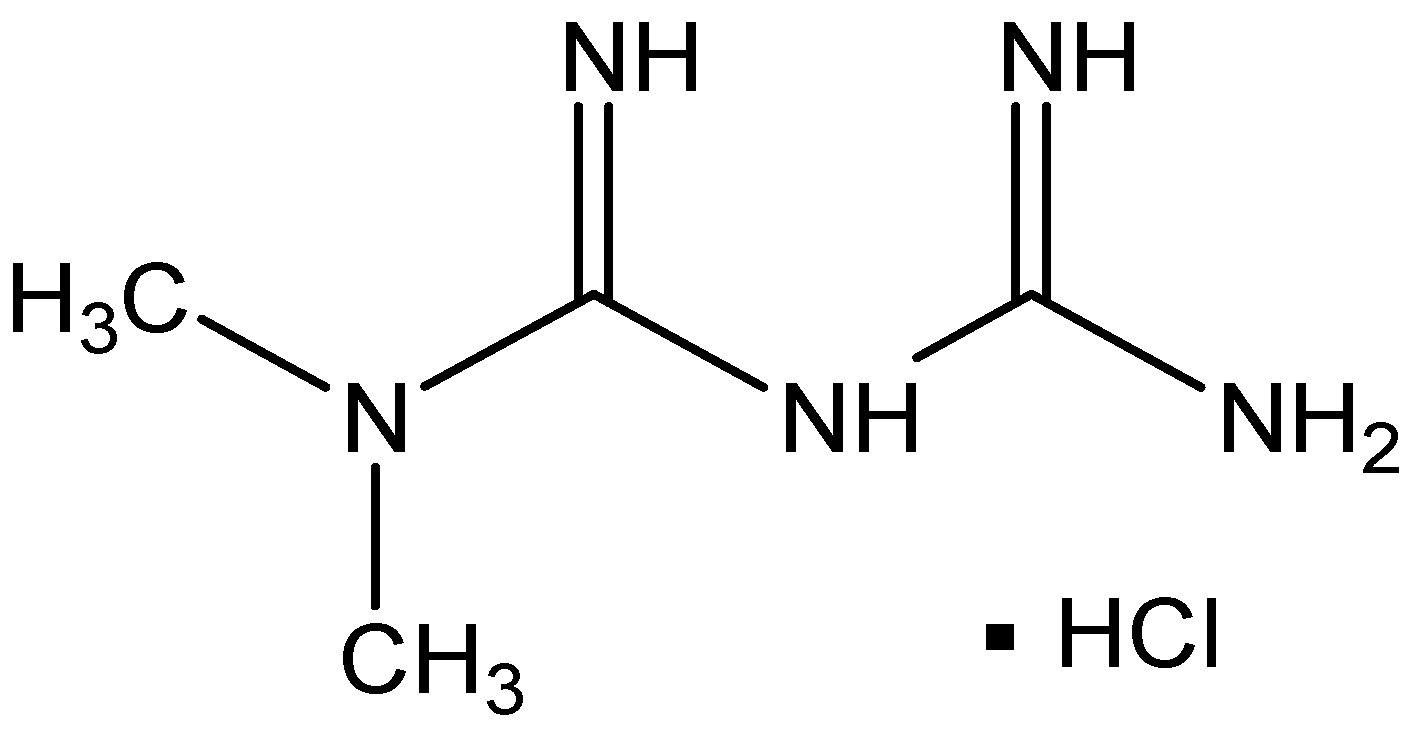
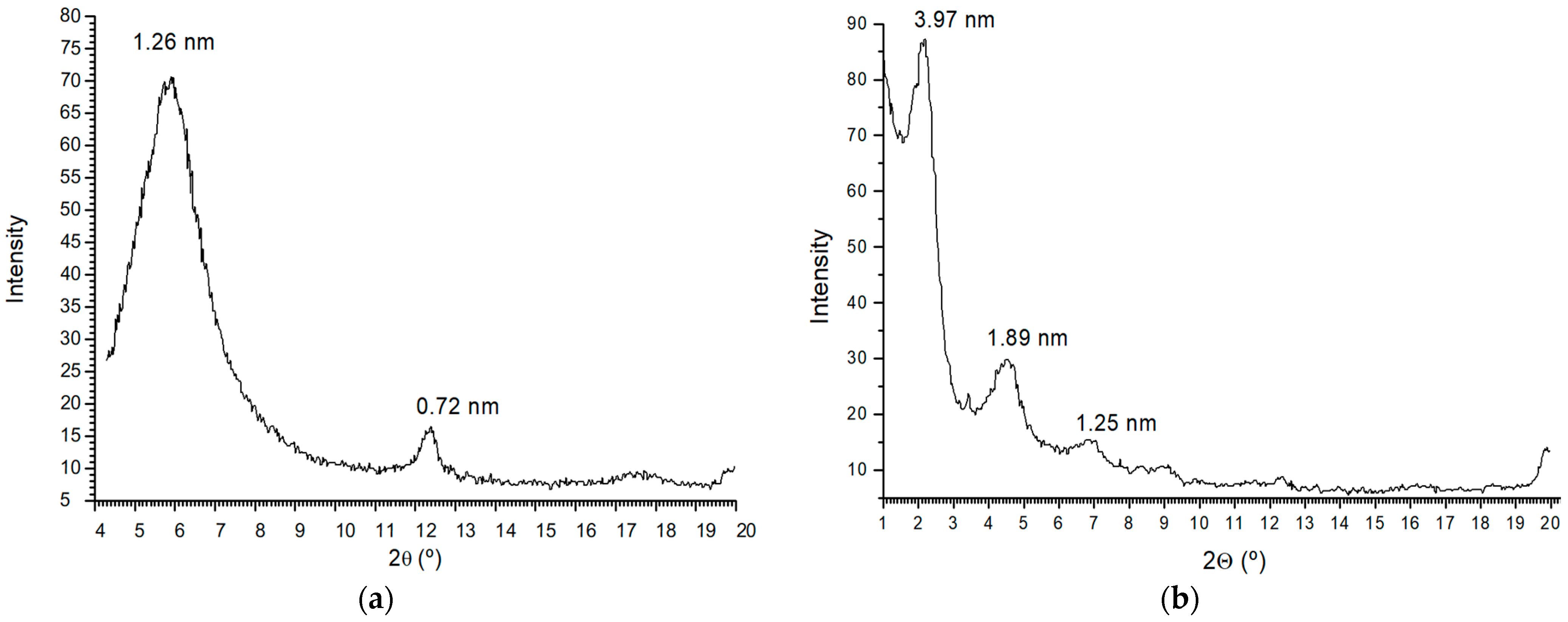
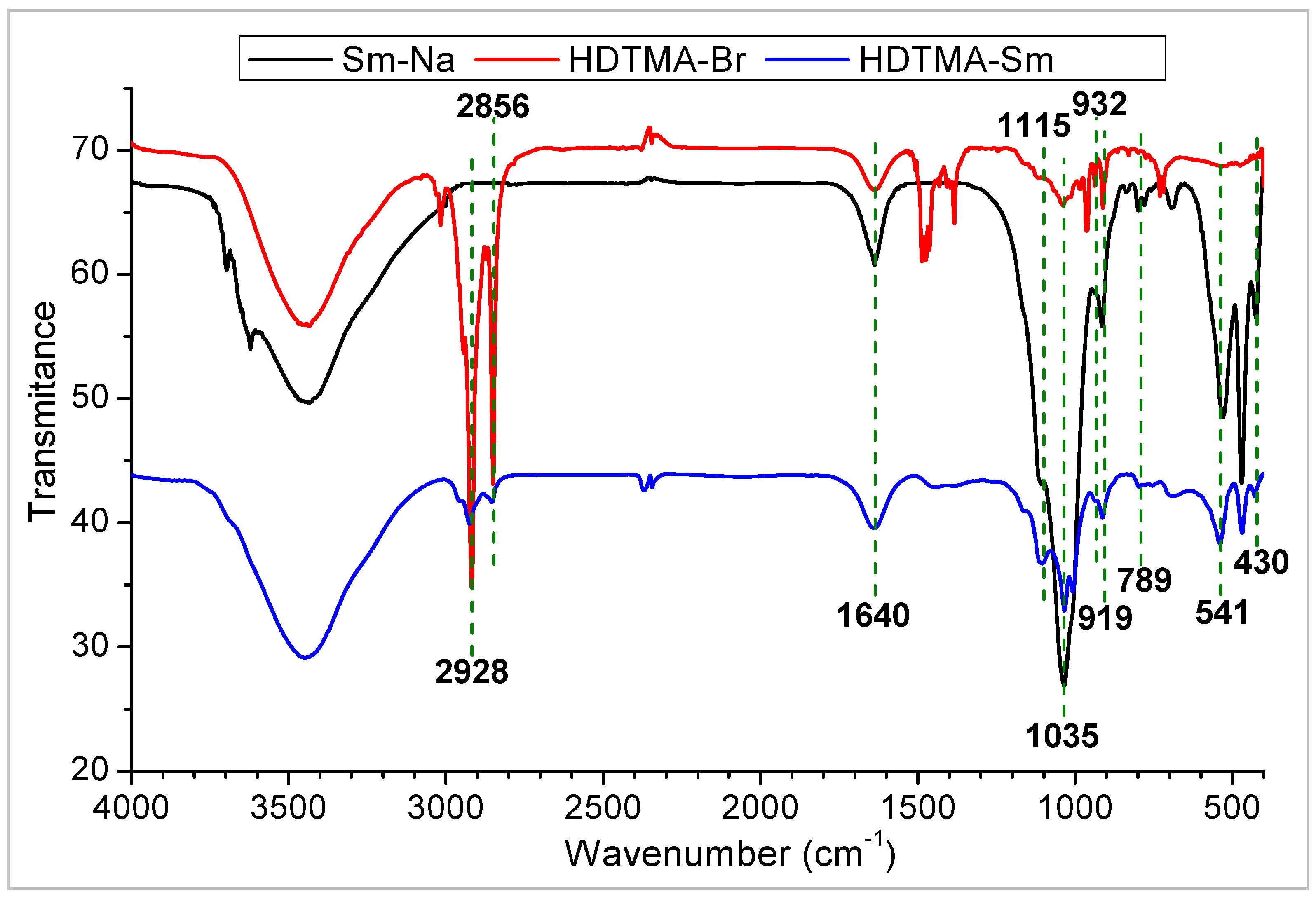


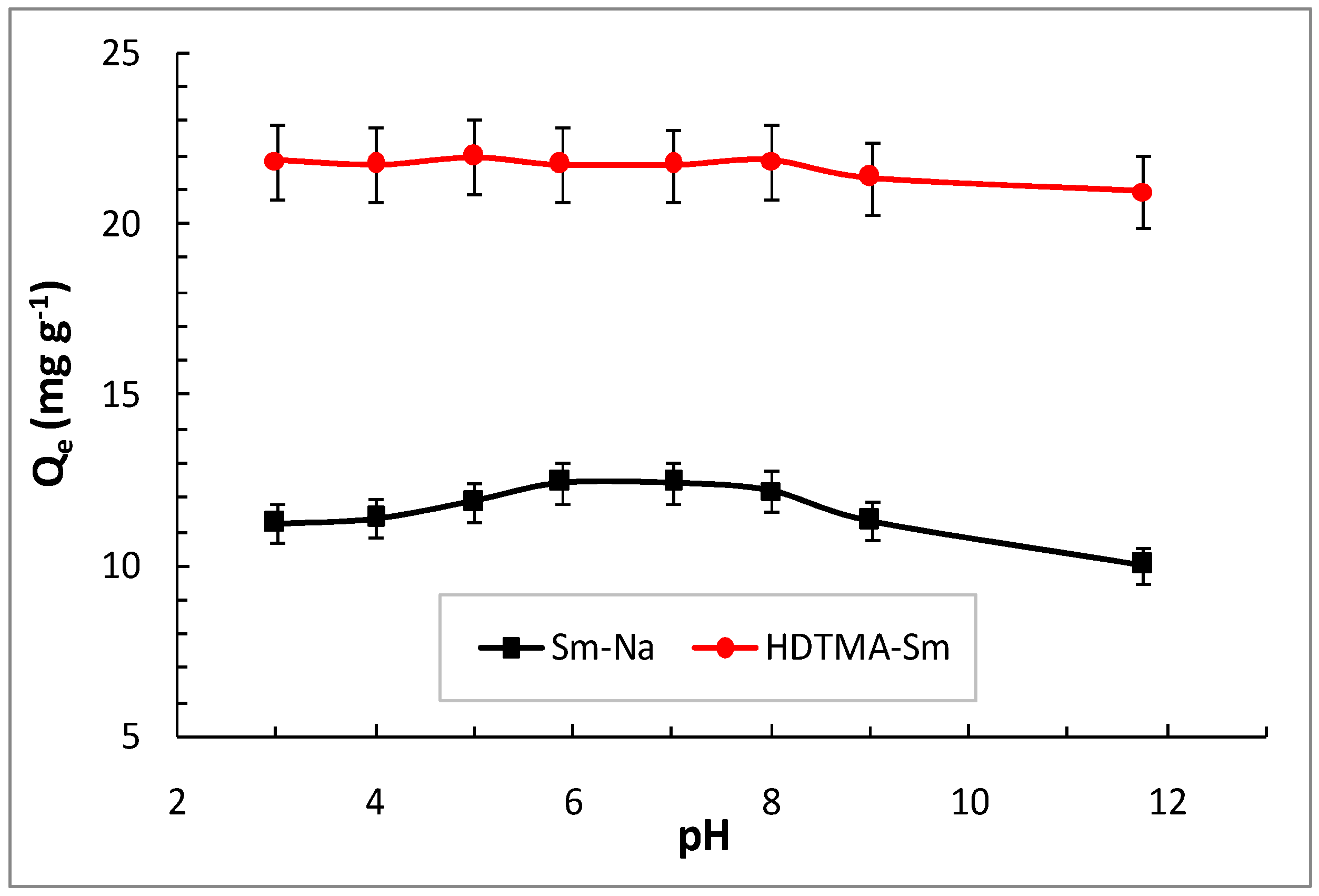
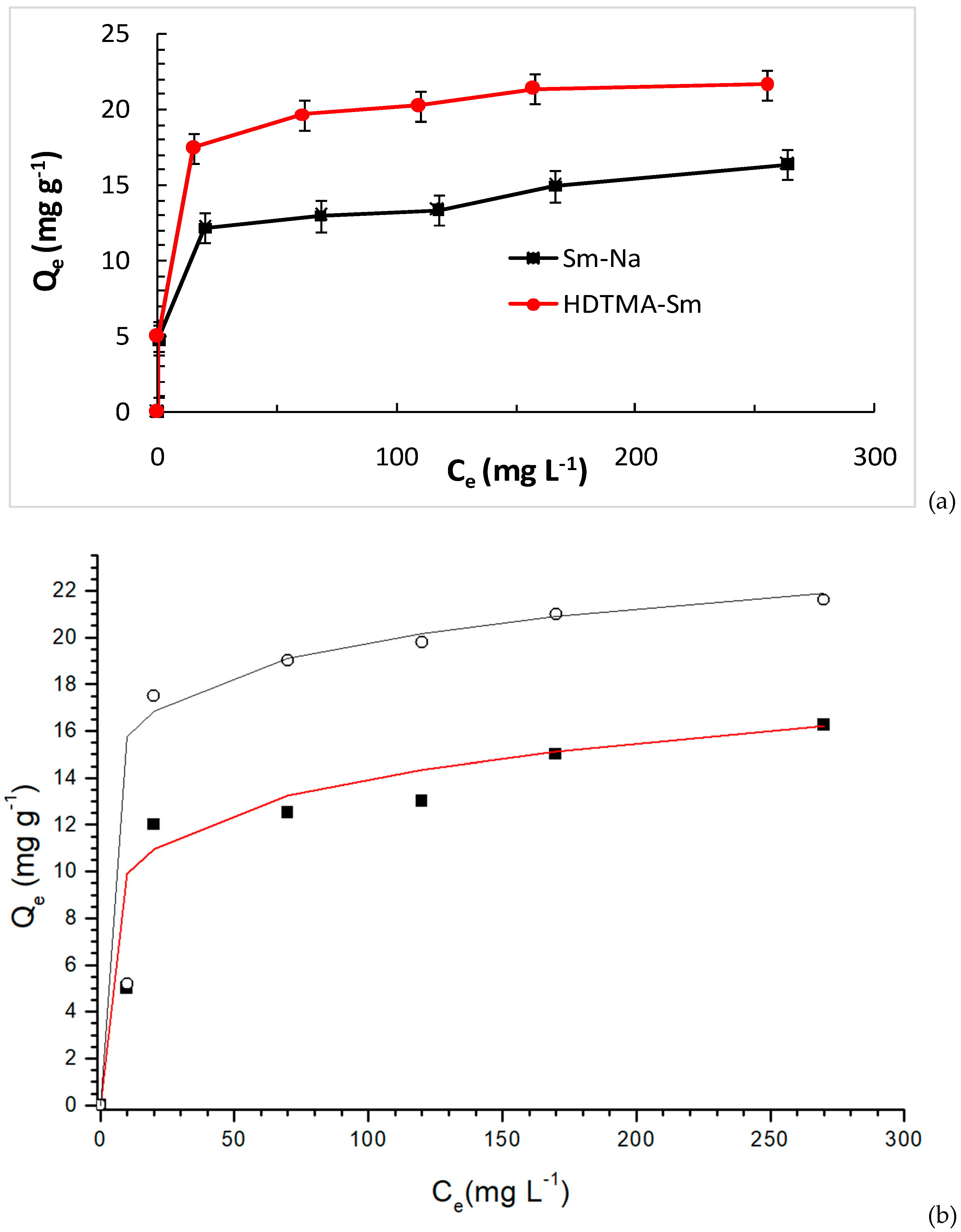


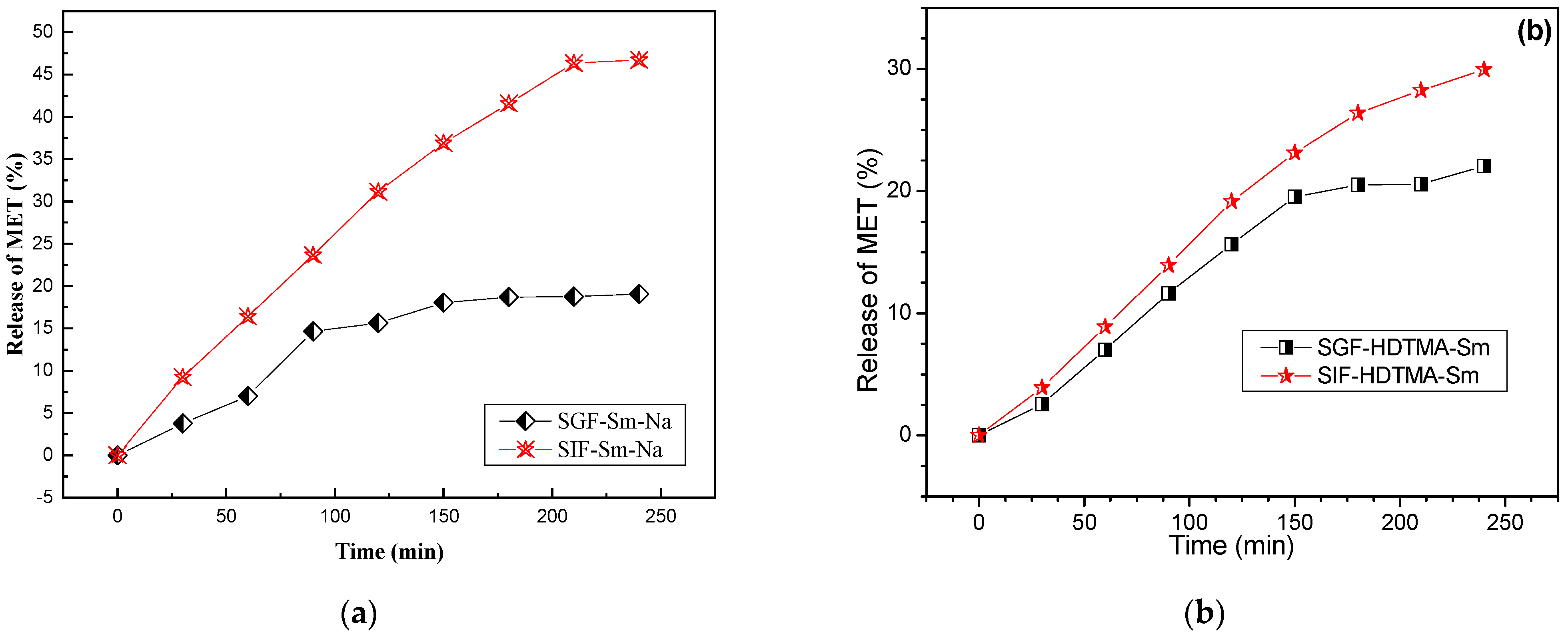
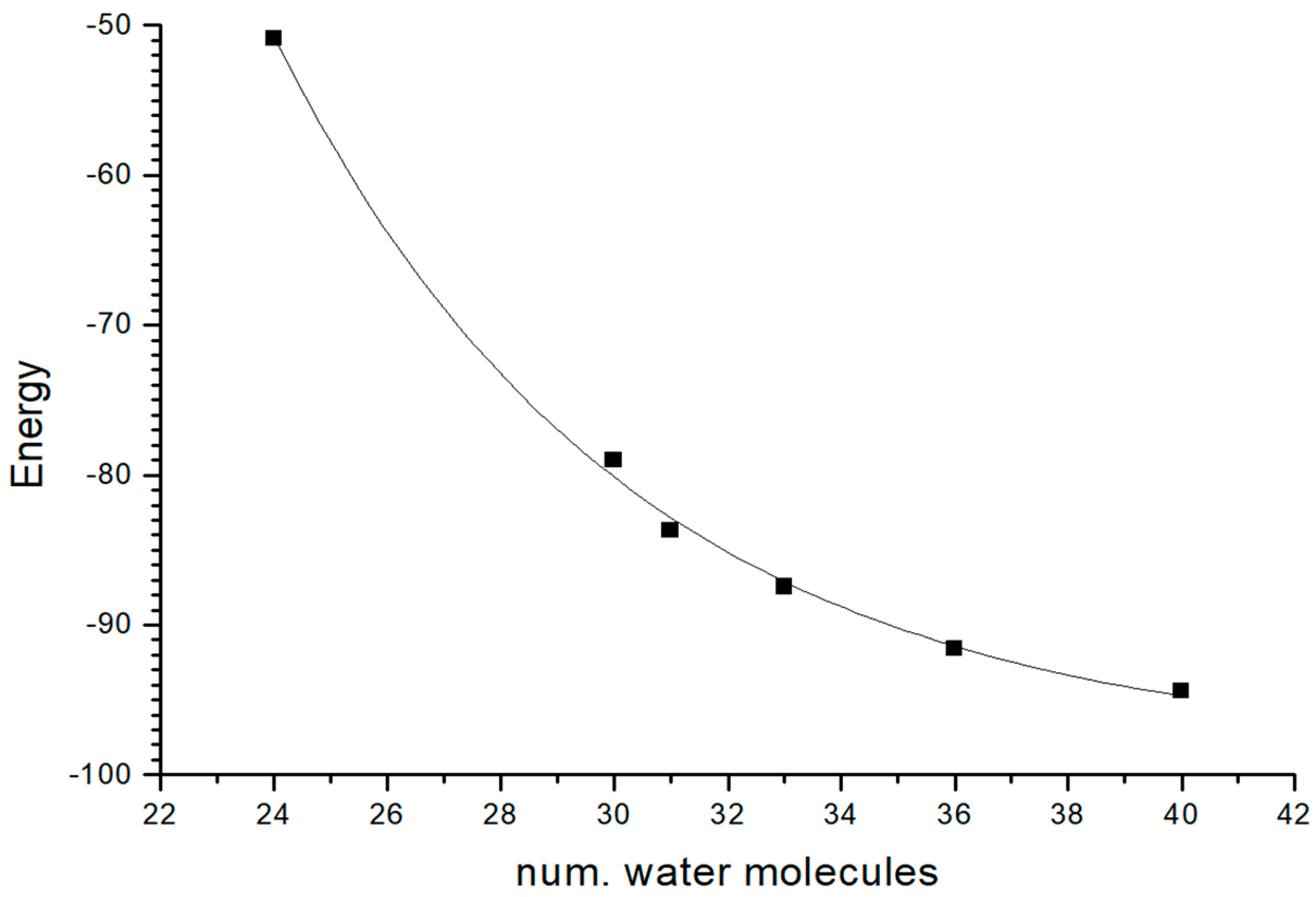

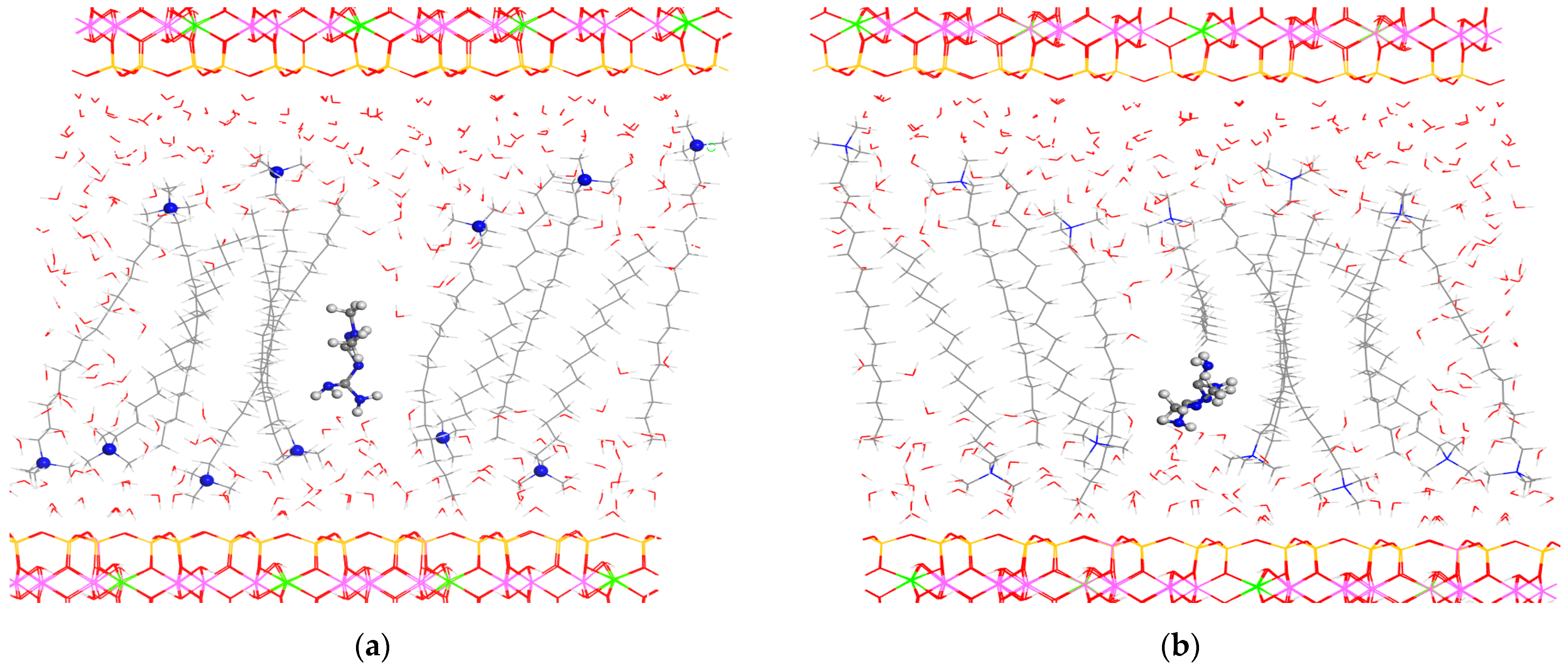
| Langmuir | Freundlich | |||||
|---|---|---|---|---|---|---|
| Qm (mg g−1) | KL | R2 | n | KF | R2 | |
| MET/Sm-Na | 16.779 | 0.00258 | 0.99 | 6.67 | 7.0 | 0.97 |
| MET/HDTMA-Sm | 21.739 | 0.00298 | 0.70 | 10.0 | 12.5 | 0.80 |
| Sample | Pseudo-First-Order | Pseudo-Second-Order | Intraparticle Diffusion | Elovich | |||||||||
|---|---|---|---|---|---|---|---|---|---|---|---|---|---|
| Qe exp (mg g−1) | k1 (mg/g min) | Qe cal (mg g−1) | R2 | k2 (mg/mg min) | Qe cal (mg g−1) | R2 | k3 (mg/mg min1/2) | Qe cal (mg g−1) | R2 | α (mg/g min2) | β (g/mg) | R2 | |
| Sm-Na | 7.384 | 0.023 | 5.928 | 0.953 | 0.004 | 8.136 | 0.996 | 0.329 | 2.179 | 0.762 | 0.618 | 0.605 | 0.921 |
| HDTMA-Sm | 9.884 | 0.027 | 6.209 | 0.949 | 0.005 | 10.604 | 0.998 | 0.391 | 3.736 | 0.729 | 1.299 | 0.501 | 0.905 |
| Adsorbents | Temperature (K) | ΔG (kJ mol−1) | ΔH (kJ mol−1) | ΔS (kJ mol−1 K−1) | R2 |
|---|---|---|---|---|---|
| Sm-Na | 298 | −10.758 | −20.89 | −0.034 | 0.950 |
| 323 | −9.908 | ||||
| 333 | −9.568 | ||||
| HDTMA-Sm | 298 | −26.81 | −89.39 | −0.21 | 0.992 |
| 323 | −23.66 | ||||
| 333 | −19.46 |
| Crystal Form | a | b | c | α | β | γ |
|---|---|---|---|---|---|---|
| CCDC1941222 | ||||||
| Exp | 5.63 | 7.26 | 52.04 | 90.0 | 93.8 | 90.0 |
| INTERFACE | 5.53 | 7.01 | 52.25 | 90.0 | 95.3 | 90.0 |
| Qeq | 5.51 | 7.33 | 51.06 | 90.0 | 96.6 | 90.0 |
| Gasteiger_q | 5.56 | 6.97 | 52.22 | 90.0 | 94.7 | 90.0 |
| CCDC1941223 | ||||||
| Exp | 5.66 | 7.38 | 26.29 | 90.0 | 90.7 | 90.0 |
| INTERFACE | 5.32 | 7.54 | 25.35 | 90.0 | 94.4 | 90.0 |
| Gasteiger_q | 5.35 | 7.53 | 25.22 | 90.0 | 94.8 | 90.0 |
| Model | a | b | c | α | β | γ | d(001) | ΔE a |
|---|---|---|---|---|---|---|---|---|
| Exp | 15.71 | 18.17 | 12.78 | 90.7 | 99.7 | 89.8 | 12.6 | |
| Sm12w | 15.48 | 17.88 | 11.63 | 90.4 | 96.3 | 90.7 | 11.56 | 0.0 |
| Sm24w | 15.47 | 17.88 | 12.20 | 89.2 | 100.4 | 90.1 | 12.00 | −50.90 |
| Sm30w | 15.48 | 17.89 | 12.39 | 85.3 | 97.6 | 90.1 | 12.28 | −79.0 |
| Sm31w | 15.47 | 17.88 | 12.41 | 85.0 | 97.7 | 90.1 | 12.30 | −83.71 |
| Sm33w | 15.47 | 17.88 | 12.82 | 83.1 | 101.1 | 90.1 | 12.58 | −87.47 |
| Sm36w | 15.48 | 17.88 | 13.02 | 87.11 | 94.5 | 90.1 | 12.98 | −91.60 |
| Sm40w | 15.48 | 17.88 | 13.86 | 82.9 | 98.7 | 90.1 | 13.70 | −94.42 |
Disclaimer/Publisher’s Note: The statements, opinions and data contained in all publications are solely those of the individual author(s) and contributor(s) and not of MDPI and/or the editor(s). MDPI and/or the editor(s) disclaim responsibility for any injury to people or property resulting from any ideas, methods, instructions or products referred to in the content. |
© 2024 by the authors. Licensee MDPI, Basel, Switzerland. This article is an open access article distributed under the terms and conditions of the Creative Commons Attribution (CC BY) license (https://creativecommons.org/licenses/by/4.0/).
Share and Cite
Omrani, S.; Gamoudi, S.; Viseras, C.; Moussaoui, Y.; Sainz-Díaz, C.I. The Use of Organoclays as Excipient for Metformin Delivery: Experimental and Computational Study. Molecules 2024, 29, 4612. https://doi.org/10.3390/molecules29194612
Omrani S, Gamoudi S, Viseras C, Moussaoui Y, Sainz-Díaz CI. The Use of Organoclays as Excipient for Metformin Delivery: Experimental and Computational Study. Molecules. 2024; 29(19):4612. https://doi.org/10.3390/molecules29194612
Chicago/Turabian StyleOmrani, Sondes, Safa Gamoudi, César Viseras, Younes Moussaoui, and C. Ignacio Sainz-Díaz. 2024. "The Use of Organoclays as Excipient for Metformin Delivery: Experimental and Computational Study" Molecules 29, no. 19: 4612. https://doi.org/10.3390/molecules29194612






